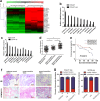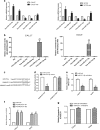LncRNA KCNQ1OT1 regulates proliferation and cisplatin resistance in tongue cancer via miR-211-5p mediated Ezrin/Fak/Src signaling
- PMID: 29970910
- PMCID: PMC6030066
- DOI: 10.1038/s41419-018-0793-5
LncRNA KCNQ1OT1 regulates proliferation and cisplatin resistance in tongue cancer via miR-211-5p mediated Ezrin/Fak/Src signaling
Abstract
Numerous findings have demonstrated that long noncoding RNA (lncRNA) dysregulation plays a key role in many human neoplasms, including tongue squamous cell carcinoma (TSCC), yet the potential mechanisms of lncRNAs in chemo-resistance remain elusive. Our research showed that the lncRNA KCNQ1OT1 was upregulated in chemo-insensitive TSCC tissues compared with chemo-sensitive TSCC specimens. Meanwhile, high KCNQ1OT1 expression was closely correlated with poor prognosis. Furthermore, KCNQ1OT1 promoted TSCC proliferation and conferred TSCC resistance to cisplatin-induced apoptosis in vitro and in vivo. Using online database analysis, we predicted that the lncRNA KCNQ1OT1 facilitates tumor growth and chemo-resistance by acting as a competing endogenous RNA (ceRNA) to modulate the expression of miR-211-5p. And miR-211-5p upregulation significantly impaired TSCC proliferation and resumed TSCC chemo-sensitivity, which is contrary to the function of lncRNA KCNQ1OT1. Luciferase experiments confirmed that miR-211-5p harbor binding sites for the 3'-UTRof Ezrin mRNA, and Ezrin/Fak/Src signaling was activated in cisplatin-resistant TSCC cells. Finally, miR-211-5p inhibition in sh-KCNQ1OT1-expressing TSCC cells rescued the suppressed cell proliferation and cisplatin resistance induced by KCNQ1OT1 knockdown. In summary, our study has elucidated the role of the oncogenic lncRNA KCNQ1OT1 in TSCC growth and chemo-resistance, which may serve as a new target for TSCC therapy.
Conflict of interest statement
The authors declare that they have no conflict of interest.
Figures







Similar articles
-
LncRNA KCNQ1OT1 contributes to the cisplatin resistance of tongue cancer through the KCNQ1OT1/miR-124-3p/TRIM14 axis.Eur Rev Med Pharmacol Sci. 2020 Jan;24(1):200-212. doi: 10.26355/eurrev_202001_19912. Eur Rev Med Pharmacol Sci. 2020. PMID: 31957833
-
Long Noncoding RNA MPRL Promotes Mitochondrial Fission and Cisplatin Chemosensitivity via Disruption of Pre-miRNA Processing.Clin Cancer Res. 2019 Jun 15;25(12):3673-3688. doi: 10.1158/1078-0432.CCR-18-2739. Epub 2019 Mar 18. Clin Cancer Res. 2019. PMID: 30885939 Free PMC article.
-
lncRNA RP5-916L7.2 correlates with advanced tumor stage, and promotes cells proliferation while inhibits cells apoptosis through targeting miR-328 and miR-939 in tongue squamous cell carcinoma.Clin Biochem. 2019 May;67:24-32. doi: 10.1016/j.clinbiochem.2019.02.013. Epub 2019 Feb 28. Clin Biochem. 2019. PMID: 30825424
-
KCNQ1OT1: An Oncogenic Long Noncoding RNA.Biomolecules. 2021 Oct 29;11(11):1602. doi: 10.3390/biom11111602. Biomolecules. 2021. PMID: 34827600 Free PMC article. Review.
-
A review on the role of KCNQ1OT1 lncRNA in human disorders.Pathol Res Pract. 2024 Mar;255:155188. doi: 10.1016/j.prp.2024.155188. Epub 2024 Feb 3. Pathol Res Pract. 2024. PMID: 38330620 Review.
Cited by
-
lncRNA KCNQ1OT1 knockdown inhibits colorectal cancer cell proliferation, migration and invasiveness via the PI3K/AKT pathway.Oncol Lett. 2020 Jul;20(1):601-610. doi: 10.3892/ol.2020.11619. Epub 2020 May 13. Oncol Lett. 2020. PMID: 32565985 Free PMC article.
-
Tumor-Associated Macrophages Promote Metastasis of Oral Squamous Cell Carcinoma via CCL13 Regulated by Stress Granule.Cancers (Basel). 2022 Oct 17;14(20):5081. doi: 10.3390/cancers14205081. Cancers (Basel). 2022. PMID: 36291863 Free PMC article.
-
Upregulation of KCNQ1OT1 promotes resistance to stereotactic body radiotherapy in lung adenocarcinoma by inducing ATG5/ATG12-mediated autophagy via miR-372-3p.Cell Death Dis. 2020 Oct 20;11(10):883. doi: 10.1038/s41419-020-03083-8. Cell Death Dis. 2020. PMID: 33082306 Free PMC article.
-
LncRNA KCNQ1OT1 Promotes Proliferation, Invasion and Metastasis of Prostate Cancer by Regulating miR-211-5p/CHI3L1 Pathway.Onco Targets Ther. 2021 Mar 3;14:1659-1671. doi: 10.2147/OTT.S288785. eCollection 2021. Onco Targets Ther. 2021. PMID: 33688211 Free PMC article.
-
Long noncoding RNA FALEC inhibits proliferation and metastasis of tongue squamous cell carcinoma by epigenetically silencing ECM1 through EZH2.Aging (Albany NY). 2019 Jul 23;11(14):4990-5007. doi: 10.18632/aging.102094. Aging (Albany NY). 2019. PMID: 31335317 Free PMC article.
References
Publication types
MeSH terms
Substances
Grants and funding
- 81402243/National Natural Science Foundation of China (National Science Foundation of China)/International
- A2016072/Guangdong Medical Research Foundation (Guangdong Province Medical Research Foundation)/International
- A2016183/Guangdong Medical Research Foundation (Guangdong Province Medical Research Foundation)/International
LinkOut - more resources
Full Text Sources
Other Literature Sources
Miscellaneous

